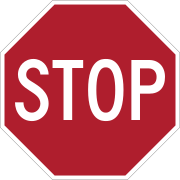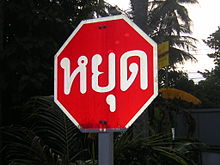Stop sign

A stop sign is a traffic sign, usually erected at road junctions, that instructs drivers to make a brief and temporary, but complete, stop upon reaching it, and then to proceed only if the way ahead is clear.
This sign is specified (with the text "STOP") in the UN Convention on Road Signs and Signals. It is one of few such signs also used in the United States. The reason for this is that it was invented in the US, and later adopted by the UN, and other countries.[citation needed]
Stop signs are not generally required at every intersection, but they are often used to control conflicting traffic movements at dangerous intersections which are not busy enough to justify the installation of either traffic lights or, especially in Europe, a roundabout. In the United States and Canada they are commonly used in residential areas, and near places where children play, as a general safety measure. In these countries it is not uncommon for stop signs to be erected on all three or four intersecting roads.
In the United States, the stop sign is not for use as a traffic calming device.[1] Stop signs are installed mainly for safety reasons and/or to assign right-of-way for a certain direction. The proliferation of stop signs where they are not warranted increases pollution, noise and delay to motorists. To make up for lost time, motorists speed up between the stop signs and may be more inclined to roll through an intersection instead of stopping completely, increasing the disregard for stop signs. Therefore, careful engineering study must be made to see if installing a sign is needed.
Standard sized stop signs are 30" long with a 3/4" white line around the edge. The letters of the stop sign are all 10" tall. Larger signs are used on multilane roadways or where driver reaction to standard sized signs is poor. Oversized stop signs can in some cases reduce crashes caused by drivers ignoring a standard sized stop sign and 'running' the junction.
The following remarks concerning the right-of-way rules at intersections with multiple stop signs apply to the United States and Canada:
- Generally, the driver who stops first continues first.
- If two drivers stop simultaneously at stop signs at a single intersection, the general rule is that the car on the right has the right of way. Common sense applies.
- Stop signs may be augmented with additional information such as a plate bearing the legend "ALL WAY". This is important, because a driver accustomed to negotiating four-way stops may falsely believe when encountering a two-way stop that cross traffic is required to stop. Since the first car to stop has the right of way at a four-way stop, this driver may believe that it is safe to turn in front of the oncoming traffic. Therefore, if there is only a plain stop sign, the assumption has to be that cross traffic will not stop. "ALL WAY" plates are provided on the fail-safe principle that if they are missing (through disrepair, vandalism, etc.) the "more dangerous" message is given.
Stop signs, usually based on an octagonal design, are found all over the world, although in Europe they tend to be used far more sparingly than in North America (with most intersections lacking traffic lights being controlled by give way signs or equivalent road markings), stop signs generally being restricted (on the principle that "familiarity breeds contempt") to situations where coming to a dead stop is absolutely essential because of poor visibility at the intersection concerned. In all countries, the driver must actually stop at stop signs even if no vehicles or pedestrians are visible. However, some drivers practice the illegal manoeuvre known as a rolling, "Chicago," or "California" stop: slowing down significantly but not stopping completely at the sign. Yield signs ("Give way" signs in the UK, Australia, New Zealand, Singapore, Hong Kong), on the other hand, require the driver only to slow and prepare to stop, but do not require an actual stop if the way ahead is clear.
The purposeful removal of stop signs began in the 1980s as a college prank and, today, one may find illegally obtained stop signs hanging in the occasional college dorm rooms. The intentional removal of stop signs from their posted locations is a crime in most U.S. states. Fatal accidents caused by someone removing a stop sign on purpose could also result in manslaughter charges against the offender.
Stop signs are often vandalized in protest-related ways. For example, the words "War" and "Bush" have been spray-painted on them, giving the meaning "Stop Bush" or "Stop War". More amusing tags have also been found on the signs like "Hammertime", as in the lyrics "Stop, Hammertime" from U Can't Touch This by MC Hammer [citation needed]
History

Stop signs originated in Detroit, Michigan in 1915. The first had black letters on a white background and were somewhat smaller than the modern one. As they became more widespread, a committee supported by the American Association of State Highway Officials (ASSHO) met in 1922 to standardize them, and it selected the octagonal shape that has been used in the United States ever since. The unique eight-sided shape of the sign allows drivers facing the back of the sign to identify that oncoming drivers have a stop sign and prevent confusion with other traffic signs.
In 1924, the sign changed to black on yellow, the predominant color scheme until 1954. Another competing group, the National Conference on Street and Highway Safety (NCSHS), simultaneously advocated an even smaller, red-on-yellow stop sign. All of these signs were typically mounted only two or three feet above the ground.
These two organizations conflicted but eventually combined into the Joint Committee on Uniform Traffic Control Devices, which in 1935 published the famous Manual on Uniform Traffic Control Devices for Streets and Highways (MUTCD) detailing the stop sign's appearance. The MUTCD stop sign was altered eight times between 1935 and 1971, mostly dealing with its reflectorization and its mounting height; the most drastic change came in 1954, when the sign gained its white-on-red color. Red is also the color for stop on traffic signals, unifying red as stop signal for drivers worldwide.
Although already widespread, use of the MUTCD stop sign passed into law in the United States in 1966. The mounting height reached its current level of 7 ft (2.1 m.) in 1971. They were later adopted by the European Union as part of its effort to standardize road travel across member countries.
Sign variants
Although English-speaking and European Union countries use the original word "STOP" on stop signs, most countries, and sometimes even smaller political districts, prefer to use a roughly equivalent word in their primary language instead; its appearance is otherwise the same of white text on a red octagon. The few known exceptions include Israel (which uses a solid white hand on a red octagon) and Japan (which uses the local word for Stop in white type on an inverted solid red triangle). Although the word used isn't universally standardized, some commonly seen examples are:
| Language | Word | Countries or regions where used | Example |
| Arabic | قف | Arab countries including Saudi Arabia | |
| Chinese | 停 (tíng) | China, Hong Kong, Taiwan In Mainland China, a stop sign is officially defined to "stop the vehicle to yield the passage" (Chinese: 停车让行; pinyin: tíng chē ràng xíng). Older stop sign pursuant to GB 5768-86 resembled a triangular Yield sign [1], with more red color, so that it was more emphatic. GB 5768-1999 replacing GB 5768-86 (link in Chinese) has adopted the red octagon that would be almost the same as, though a little different from, the Taiwanese stop sign. However, the red triangular stop sign is still used in Japan (see below). In Hong Kong both English and Chinese Language appears on the same stop sign, with English on top of Chinese. In Taiwan, a standard stop sign is in Chinese only. English supplemental plates may be used, but they are rare on the road. |
  |
| English | STOP | Australia, Canada outside of French-speaking Quebec and bilingual New Brunswick, European Union countries, Hong Kong, Russia, Serbia, Singapore, United States. | 
|
| French | ARRÊT | Parts of Canada such as Quebec, New Brunswick and areas operated by the Federal government. In Quebec, New Brunswick, and in the National Capital Region of Ontario and Quebec (Ottawa, Ontario and the surrounding suburbs in both Ontario and Quebec) it is common to find signs that are both unilingual French ("ARRÊT") or signs that are bilingual French and English ("STOP ARRÊT", or, more rarely, "ARRÊT STOP"). It is interesting to note that in Québécois French stop signs, the word "ARRÊT" is the noun form of the word "Stop", as in "a stop". In France, the English word "STOP" is used on all stop signs, due to European Union standardization. | 
|
| Huron | SETEN | In parts of Canada with Wyandot people. Often seen as bilingual "ARRÊT SETEN" signs. | |
| Inuktitut | ᓄᖅᑲᕆᑦ | Nunavut, Canada | 
|
| Italian | STOP | The new sign, in use since the 30 april 1992 decree, is the common STOP signal. |  New Italian stop sign.  Former Italian stop sign consisting of red "Give Way" triangle inside a circle. |
| Japanese | 止まれ | The Japanese Stop Sign resembles a triangular Yield sign, with more red color, so that it is more emphatic. | File:JapaneseStopSign.png |
| Korean | 정지 | South Korea | |
| Malay | BERHENTI | Malaysia | |
| Portuguese | PARE | Brazil | 
|
| Spanish | ALTO | Costa Rica, El Salvador, Guatemala, Honduras, Mexico, Nicaragua, Panama | |
| Spanish | PARE | Argentina, Bolivia, Chile, Colombia, Cuba, Dominican Republic, Ecuador, Peru, Puerto Rico, Venezuela | 
|
| Spanish | STOP | Spain (due to EU rules specifying English as the language of this road sign) | 
|
| Thai | หยุด | Thailand |  |
| Turkish | DUR | Turkey, Turkish Republic of Northern Cyprus | |
| English / Spanish | STOP/ALTO | Along United States-Mexico border, and rarely seen in Puerto Rico | File:ALTO-STOP.jpg |
See also
External links
- History of the Stop Sign in America
- Stop Signs from Around the World
- A Collection of Stop and Yield Signs
- Road and Traffic Signs from Israel
